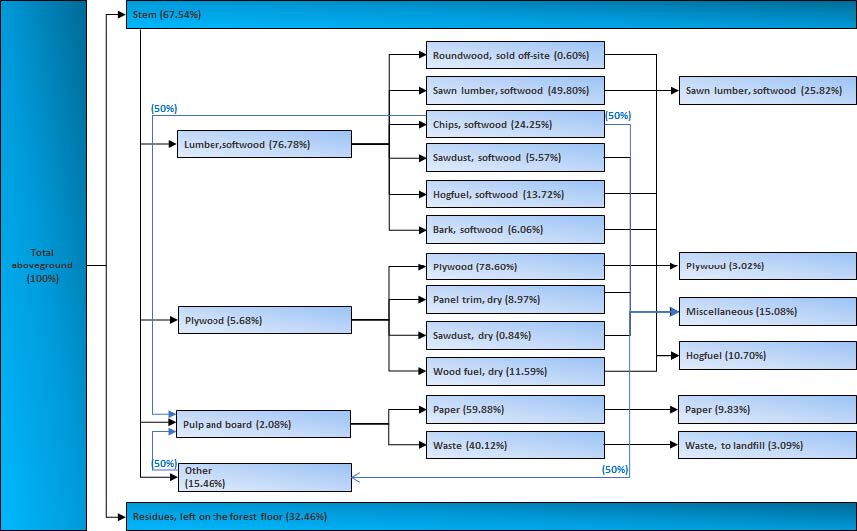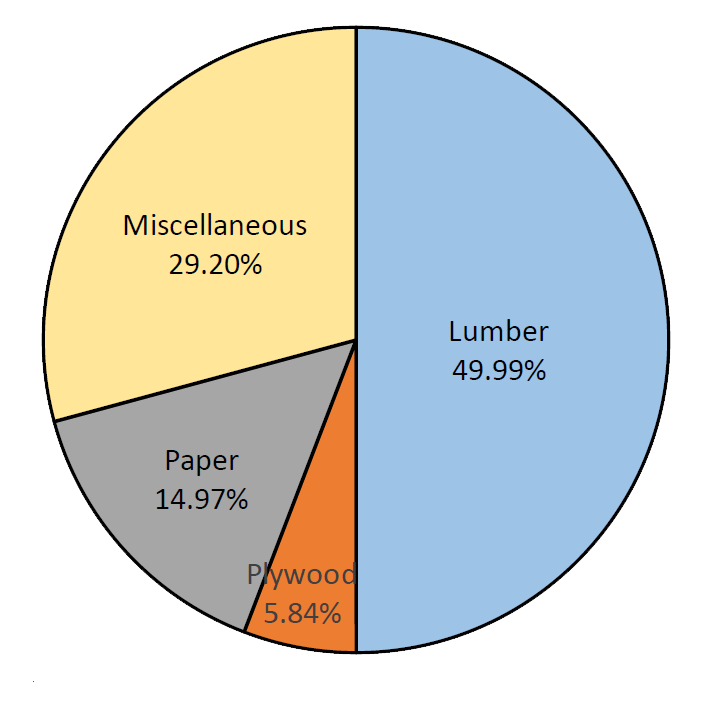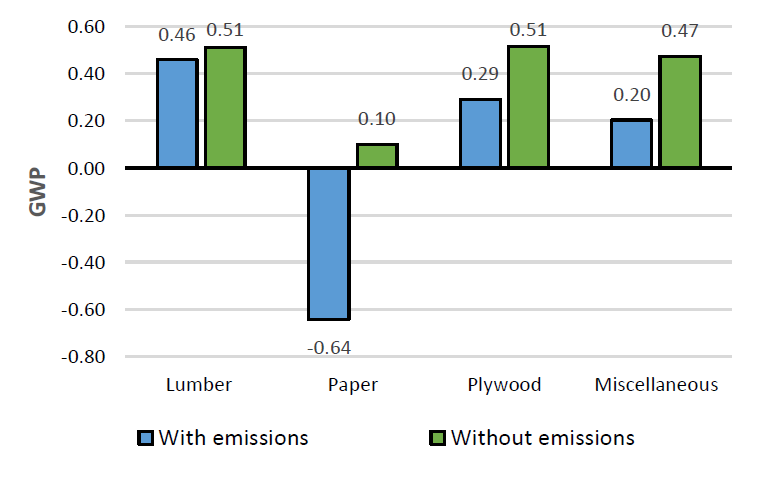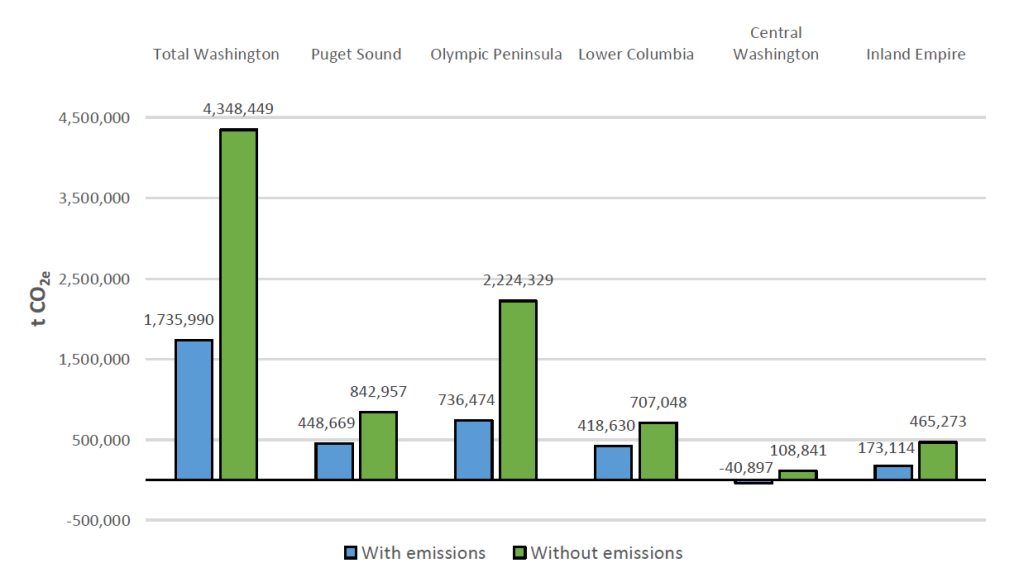Global warming mitigating role of working forests in Washington State
Authors: Indroneil Gangulya, Francesca Pierobona, Edie Sonne Hallb, Olivia Jacobs
Introduction
The Pacific Northwest, especially western Washington and Oregon, is known for its fast-growing forests and vibrant forest industry. With 1.5 billion ft3 net yearly growth in softwood and 0.8 billion ft3 net harvest, Washington is the second largest producer of wood products in the United States, including sawn lumber and plywood. This study sets out to understand the role of Washington’s working forests in mitigating global warming. A comprehensive analysis of the region-specific private forestland is performed, taking into account current growth and harvesting practices, the wood product distribution mix, and the emissions associated with harvesting and manufacturing wood products. This study incorporates temporal dynamics of wood product manufacturing and storage by applying a radiative forcing (RF) analysis. Radiative forcing represents the net atmospheric impact of keeping carbon out of the atmosphere for a given length of time. We simultaneously calculate the global warming potential of emissions associated with manufacturing wood products and the global warming mitigating potential of keeping the carbon sequestered within wood products during their functional lifetime. Using a comprehensive wood products mix, this study incorporates radiative forcing analysis to examine the global warming mitigating impact of current Washington forest practices and production outcomes.
Methods

The global warming mitigating potential of Washington’s working forests is estimated using the following multi-step approach:

- Evaluation of the net carbon sequestration of working forests: we calculate the total aboveground and harvest biomass (merchantable and residues components) over a 20-year period, between 2010 and 2030, at parcel level, using Washington Forest Biomass Supply Assessment tool. Forested plots are simulated using the appropriate Forest Vegetation Simulator (FVS) variant, including a total of six variants to capture the variation in growth and yield in the state. The data is used to calculate the carbon sequestration, by assuming a carbon content in the biomass of 50%.
- Creation of a wood products mix scenario: various wood products manufacturing data is used to create a wood products mix scenario, including different uses of the merchantable harvest from private forests in Washington State in 2015 (Figure 1). Hogfuel, bark and wood fuel are considered as hogfuel. Hogfuel and waste are excluded from the storage evaluation because their lifetime is <1 year. The wood products mix is represented in Figure 2.
- Evaluation of the global warming mitigating potential of wood products: a Radiative Forcing analysis is performed to estimate the overall global warming potential of Washington’s wood products from working forests. The analysis includes carbon in wood products using the wood products mix.
- Evaluation of the total global warming mitigation potential of Washington State’s private lands and wood products industry: the global warming mitigation potential of each wood product is applied to the Washington state wood products mix. The detailed analysis focuses only on wood products harvested from private lands in Washington State, which comprises 73% of total harvest in 2015.
Results
The results of the temporal RF analysis over a 100-year timeframe, performed with and without including fossil emissions, are represented in Figure 3. Softwood lumber, plywood and other miscellaneous wood products show significant climate benefits. This environmental calculation factors in cradle-to-gate fossil emissions, including, harvest, transportation, and production emissions. The fossil emissions play an important role in the net climate benefit of the wood products industry. Lumber has the largest potential climate change benefit out of all forest products that we considered. This is primarily driven by the relatively low emissions associated with producing lumber. Paper products result in a positive RF value (i.e. increasing climate change) when we consider emissions associated with their production. When we do not consider the emissions, paper products only provide a small climate benefit due to their short lifetime. Out of all products considered, paper has the highest level of emissions associated with its production.

These results indicate that the carbon stored in the biomass of many wood products could further enhance the carbon sequestration capabilities of forests and forest products and reduce climate change impacts. However, under some production scenarios, the emissions associated with production will outweigh the potential climate benefit of carbon storage in a product, such as in the case of paper.
This product-specific RF analysis also demonstrates that extending forest product lifetimes would enhance the climate benefits of forest products by sequestering carbon for a longer timeframe. Effective carbon storage policies could therefore encourage extending product lifetimes, such as through reuse or refurbishment, to keep carbon in its sequestered form.
The global warming potential numbers are then multiplied by the overall WA wood products mix to estimate a net environmental role of the wood products industry (Figure 4). Based on 2015 WA state wood products manufacturing data, it can be concluded that overall the wood products industry has a net global warming mitigating benefit.
Washington state’s wood products contribute to a global warming mitigation of about 4.3 million tCO2e, if production emissions are excluded. When production emissions are included, there is still a net benefit from just the wood products alone, equivalent to about 1.7 million tCO2e. All these benefits are underpinned by net carbon sequestration on Washington state lands.

In 2008, the Washington Legislature established greenhouse gas emission reduction goals, which include reducing overall greenhouse gas emissions in the state to 1990 levels by 2020, to 25% below 1990 levels by 2035 and 50% below 1990 levels or 70% below the state’s expected emissions that year by 2050. According to Department of Ecology’s latest report, in 2013, Washington greenhouse gas emissions were 94.4 million tCO2e, 6 million tCO2e higher than the 1990 baseline of 88.4 million tCO2e.
Washington state’s wood products output from private forests has a global warming mitigation potential equivalent to about 5% of the total state greenhouse gas emissions, while the net forest growth of private forests after harvesting corresponds to an additional 8%. Summing these two components, we can conclude that the total benefit on global warming of wood products and net forest growth (after harvesting) in private forests is about 13% in 2015.
Conclusions
The results of this study highlight that the wood products industry from Washington state’s private forests has a net global warming mitigating benefit on global warming. Overall, Washington state’s wood products contribute to a global warming mitigation of about 4.3 million tCO2e, if production emissions are excluded. When production emissions are included, there is still a net benefit from just the wood products alone, equivalent to about 1.7 million tCO2e in 2015.
